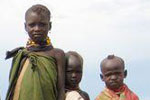Nature study finds Wars twice as likely during hot, dry years

Armed men on the island of New Guinea, which has seen its fair share of civil conflict. Photo by: Rhett A. Butler.
Civil war is twice as likely in tropical countries during particularly hot and dry years, according to a new study in Nature. The researchers found that El Niño conditions, which generally cuts rainfall and raises temperatures in the tropics, may have played a factor in one-fifth of the world’s total conflicts during the past 50 years. El Niño conditions occur every 3-7 years. While the study did not examine global climate change in conjunction with conflict, the study links a warmer world to a more conflict-prone one, as least in the tropics.
“We can speculate that a long-ago Egyptian dynasty was overthrown during a drought. That’s a specific time and place, that may be very different from today, so people might say, ‘OK, we’re immune to that now.’ This study shows a systematic pattern of global climate affecting conflict, and shows it right now.” Solomon M. Hsiang, the study’s lead author and PhD graduate of sustainable development at the Columbia University’s Earth Institute, said in a press release.
Examining 234 civil conflicts in 175 countries (in which at least 25 people died) from 1950 to 2004, researchers found that climate played an important role in the tropics. Civil conflict occurred about 3 percent of the time during La Niña years (cooler and wetter) in the tropics and 6 percent during El Niño years (dryer and hotter), essentially doubling the chance of conflict.
“No one should take this to say that climate is our fate,” cautioned co-author Mark Cane, a climate scientist at Columbia’s Lamont-Doherty Earth Observatory. “Rather, this is compelling evidence that it has a measurable influence on how much people fight overall. It is not the only factor—you have to consider politics, economics, all kinds of other things.”
Solidifying the link between climate and conflict, however, the study found that in countries not impacted by the El Niño-Southern Oscillation (which spawns El Niño and La Niña conditions) the chance of conflict remained steady at 2 percent.
According to the authors El Niño climate appears to exacerbate tensions already in place, pushing stand-offs and threats of violence into civil war. For example, the pattern can be seen repeatedly in the Sudan when, during a series of El Niño drought years (1963, 1976, and 1983), when smoldering tensions burst out into full-scale war, the final one lasting two decades. Other conflicts that rose with El Niño droughts include Peru’s civil war against the Shining Path set-off in 1982, a coup in Haiti during 1991, worsening civil conflict in the Congo in 1997 that eventually led to the second Congo Civil War, and revolution in Indonesia that began in 1997.
“If you have social inequality, people are poor, and there are underlying tensions, it seems possible that climate can deliver the knockout punch,” adds Hsiang.
Researchers have come to increasingly see a link between climate, especially long droughts, and the collapse of past civilizations: the fall of the Akkadian empire in 2,154 BC, the end of the Mayan empire between 800-900 AD, and the end of Angkor in 1400 AD among others.
Related articles
World nations see six all-time record high temperatures, no lows so far in 2011
(08/16/2011) Eight months into the year, six nations have seen record high temperatures, including Kuwait, Iraq, Armenia, Iran, and Republic of the Congo, reports Jeff Master’s Wunderblog. To date no record lows have been recorded in any country in the world so far. This is similar, though not quite as extreme, to last year when twenty countries broke all time highs with none hitting an all time low.
Adaptation, justice and morality in a warming world

(07/28/2011) If last year was the first in which climate change impacts became apparent worldwide—unprecedented drought and fires in Russia, megaflood in Pakistan, record drought in the Amazon, deadly floods in South America, plus record highs all over the place—this may be the year in which the American public sees climate change as no longer distant and abstract, but happening at home. With burning across the southwest, record drought in Texas, majors flooding in the Midwest, heatwaves everywhere, its becoming harder and harder to ignore the obvious. Climate change consultant and blogger, Brian Thomas, says these patterns are pushing ‘prominent scientists’ to state ‘more explicitly that the pattern we’re seeing today shows a definite climate change link,’ but that it may not yet change the public perception in the US.
Food security in developing world threatened by climate change

(06/06/2011) If swift action is not taken to prepare farmers in the developing world for hotter, drier, shorter growing seasons, climate change may threaten the lives of hundreds of millions of people by 2050. People in Africa and South Asia are particularly at risk of further impoverishment and hunger in a warmer world. According to the UN, a billion people are already going hungry worldwide.







